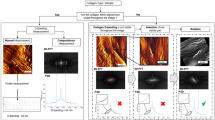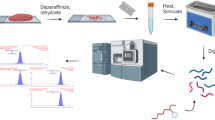Abstract
IN the early stages of collagen fibrogenesis, soluble forms of collagen can be extracted with salt solutions; as the tissue develops, dilute acids and acidic buffers are needed. Eventually these reagents also become ineffective as a relatively insoluble form of collagen is elaborated. This transformation or “maturing” is believed to be caused by an increase in the number of intramolecular and intermolecular cross-links1.
This is a preview of subscription content, access via your institution
Access options
Subscribe to this journal
Receive 51 print issues and online access
$199.00 per year
only $3.90 per issue
Buy this article
- Purchase on SpringerLink
- Instant access to full article PDF
Prices may be subject to local taxes which are calculated during checkout
Similar content being viewed by others

References
Verzar, F., in Intern. Rev. Connect. Tissue Res., edit. by Hall, D. A., 2, 245 (1954).
Courts, A., Biochem. J., 74, 238 (1960).
Higgs, D. A., and Reed, R., Biochim. Biophys. Acta, 78, 265 (1963).
Smithies, O., Biochem. J., 71, 585 (1959).
Author information
Authors and Affiliations
Rights and permissions
About this article
Cite this article
CARMICHAEL, D. Electrophoretic Fractionation of Heat-denatured Eucollagen. Nature 211, 861–862 (1966). https://doi.org/10.1038/211861a0
Issue date:
DOI: https://doi.org/10.1038/211861a0


